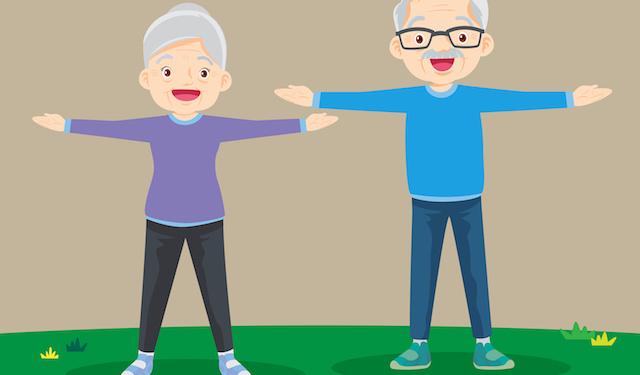Health Blog
Check out these 4 exercises to help reduce the risk for falls.

If you’re an older adult, a fear of falling may weigh on you every day. This is completely understandable, as falls are the top cause of injury for those over the age of 65. Falls also become more common with each additional year of life that passes due to the increased likelihood of developing other health conditions.
But you should not allow this fear to dominate your life or prevent you from moving. A far more beneficial response is to figure out what you need to do to overcome this fear entirely. And how might this be accomplished? By taking steps to significantly reduce your personal risk for falling.
Falls are usually the results of both environmental hazards–like a loose rug or icy walkway–and personal factors like poor balance or mobility. Reducing or eliminating environmental hazards in your home is one of the most important steps to preventing falls, but it’s only part of the solution, especially when you consider that you can’t control the environment outside of your home. The other major step is to keep yourself mobile and active, which will help you to retain your abilities and address any impairments that might be holding you back.
General physical activity that’s carefully executed is a great start, but to truly lower your fall risk, specific exercises are best. Strength, flexibility, balance, and proprioception (sensing your body’s location relative to other things and controlling its positioning) all tend to decline naturally in older age, so these are the areas that are most crucial to work on. With that in mind, here are the four best exercises designed to strengthen your weaknesses and reduce your risk for falling:
Single–leg stance exercise: improves your balance on each leg, which will in turn help with overall balance
- Hold on to the back of a chair with both hands
- Slowly lift one leg off the ground and maintain your balance while standing on one leg for 5 seconds
- Return to the starting position and repeat 5 times; try to increase the time spent standing on one leg
- Perform with the opposite leg
Heel–to–toe walk: helps you better maintain your balance while moving and encountering obstacles
- Position the heel of one foot just in front of the toes of your other foot (your heel and toes should touch or almost (touch)
- Choose a spot ahead of you and focus on it to keep you steady as you walk
- Take a step by putting your heel just in front of the toe of your other foot
- Continue for 20 steps total, then turn around and return
- Repeat five times
Sit–to–stand exercise (basic):strengthens your leg, core, and back muscles, increases overall mobility, and improves balance
- Scoot or walk your hips up to the edge of the chair
- Bring your toes back underneath knees
- (Optional: use your arms to push off the chair or your knees)
- Lean forward a little to bring your nose over your toes and push up with your legs to a standing position
- To sit, bend a little at the knees to push your hips toward the chair and lower your body to a seated position
- Pause before doing the next repetition
- Aim for 10 repetitions
Heel raise: strengthens the calf and thigh muscles to improve balance
- Stand with the back of a chair in front of you
- Keep your feet 6–8 inches apart, flat on the floor, and parallel to each other
- Bend your knees slightly so that they are not locked out
- Elevate your heels to rise on to the balls of your feet; while in motion, use the back of the chair for balance
- Reverse the motion to the starting position
- Try to complete at least 2 sets with 10–15 repetitions
Making these exercises a regular part of your routine will build your strength and improve your flexibility, balance, and proprioception. This, in turn, will lead to better overall functioning and will reduce your fall risk. So what are you waiting for?
March 19, 2020
Back to Health BlogHEALTH BLOG
- A Personalized Physical Therapy Program Can Assist with Whiplash
- Why Older Adults Should Incorporate an Exercise Program
- After an Achilles Injury, Physical Therapists Can Help with Recovery
- AI Can Answer Questions But It’s Best to See a Physical Therapist
- Physical Therapy Can Help With Symptoms of Wryneck
- Reduce the Risk of Pickleball Fractures By Taking Proper Precautions
- Physical Activity May Slow the Progression of Parkinson's Disease
- Too Much Salt in Your Diet? Learn the Dangers of High Sodium Intake
- Suffer From Lower Back Pain? Might Be Time to Take A Break
- The Road to Recovery: Preventing Re-Injury After ACL Surgery
RECENT ARTICLES

- 11 Possible Reasons Your Back HurtsJune 22, 2020

- What Conditions Can a Chiropractor Treat?May 25, 2020

- A Simple Guide to Better PostureApril 30, 2020

- Is Acupuncture Right for Me When I’m Afraid of Needles?March 30, 2020

- Stretching Done Right — How and When to StretchFebruary 26, 2020

